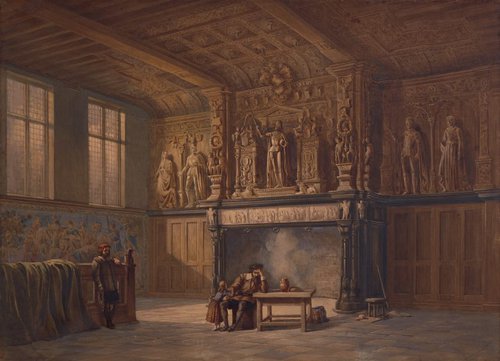John Chase
England
Born: London, England 23 Feb 1810
Died: London, England 08 Jan 1879
Biography
John Chase received early instruction from John Constable before going on to study architecture, the mainstay of his art. He became a member of the New Society of Painters in Water Colours in 1835, and was a regular and prolific exhibitor. He was the author of A practical treatise on landscape painting and sketching from nature in water-colours (1861).
Historic buildings and their interior decoration, both as objects of antiquarian study and as suitable subjects for painting, became a preoccupation of many Victorian watercolourists, particularly those who, like Chase, were trained as architects.
In keeping with the popular taste for romantic historical set pieces, artists very often placed imaginary figures from the past into their accurately delineated interiors.
In Interior of the Hall of Justice, Bruges c1846 in the Art Gallery of NSW collection, the setting is the Aldermen’s Room – a court chamber where minor cases were heard – in the Palace of the Liberty of Bruges. The enormous chimneypiece, a masterpiece of Flemish Renaissance carving, represents the Holy Roman Emperor, Charles V, and other Habsburg rulers. It was completed in 1531 under the supervision of the Bruges artist, Lancelot Blondeel.
For Chase, the 16th-century chamber becomes a stage set for a sentimental drama inspired by an event in the life of a craftsman who had purportedly worked on the room’s splendid carvings. The fanciful story is described in the Album Pittoresque de Bruges (1837–40) from which the following excerpt was quoted in the catalogue of the New Society of Painters in Water Colours in 1846, when Chase’s picture was first exhibited:
‘This wonderful specimen of wood sculpture… is the chefd’oeuvre of an artist, named Andrea, who was falsely accused of assassination; condemnation was about to be passed, but his talent, and his friends procured a suspension of judgement; meanwhile he was ordered to employ himself on some work of art, for the Palais de Justice. The sombre hall, in which he had been tried, struck his imagination, and he resolved to leave a work behind, which would perpetuate his memory. Andrea completed his task, but became overwhelmed with grief, from which his child (a daughter) who was allowed to visit him, in vain endeavoured to arouse him. The magistrates went to inspect his work, which called forth general admiration; they found him pale and haggard, more like a spectre than a man; on leaving him, they promised to send news next day that would reanimate his heart. Early next morning the officers presented themselves at the prison, with an order for his liberation, but when they entered his apartment, they found Andrea dead.’
Adapted from Victorian watercolours, Art Gallery of New South Wales, Sydney 2017
